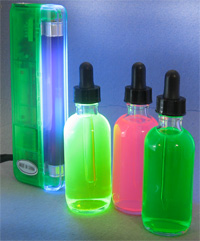Glow-In-The-Dark.
Introduction...
Luminol is a versatile chemical that demonstrates chemiluminescence when mixed with the proper oxidizing agent. It is supplied as a whitish-yellow crystalline powder that is soluble in high pH (potassium hydroxide added) water solutions. Luminol is used by forensic investigators for blood trace detection because when properly mixed it will react with iron found in hemoglobin. It is also used by biologists in cellular assays to test for the presence of copper, iron, and cyanides.
Activity 1: Chemiluminescence.
Discussion...
To produce a blue glowing reaction, luminol powder is mixed with a liquid containing hydrogen peroxide, a hydroxide such as potassium hydroxide, and a catalyst such as potassium ferricyanide. The mixture’s blue glow is evidence of the presence of the catalyst which accelerates the chemiluminescence reaction. (Iron in hemoglobin for the forensic scientist or iron in the potassium ferricyanide in our laboratory mixture.) One gram of luminol will produce about 125ml of solution.
Supplies needed...
- 1g luminol
- 8g potassium hydroxide
- 125ml water
- 10ml 3% hydrogen peroxide (common store-bought concentration)
- ~0.1g Potassium ferricyanide
- Three small beakers.
Procedure...
- Solution A: In one of your beakers, add 1g luminol, 8g potassium hydroxide to 125ml of distilled water. Stir thoroughly with a glass stir rod or stainless steel mixing spoon to completely dissolve the chemicals.
- Solution B: In another beaker, add at least 10ml hydrogen peroxide PLUS just a pinch (~0.1g) of Potassium ferricyanide to act as a catalyst.
- In third beaker measure 10ml of Solution A then add 10ml of Solution B to activate the blue glow.
Rather than iron, you can also catalyze the luminol reaction by adding copper and its compounds (such as copper sulfate), horseradish, or bleach.
Activity 2: Make Your Own Glow "Sticks".
Discussion...
First, you’ll see only a small amount of chemicals are required to create the necessary solutions which then combine to GLOW in a glass container. While the glow-effect is relatively short lived, the amount of prepared A and B solutions allows for a number of repetitions of the experiment.
Supplies needed...
- 2 liters distilled water.
- 50 milliliters 3% hydrogen peroxide (common store-bought concentration)
- 0.2 grams luminol.
- 4 grams sodium carbonate.
- 0.4 grams cupric sulfate.
- 0.5 grams ammonium carbonate.
- Two containers that hold at least 1 liter of liquid each (glass beaker, glass mixing bowl, glass jar, etc).
- Graduated cylinder (cylinder should allow you to measure out 50 milliliters and 1000 milliliters).
- Glass stir rod or stainless steel mixing spoon.
- Small vials or containers with lids to make into your glow sticks.
Procedure...


- Solution A: In one of your containers, add 50 milliliters hydrogen peroxide 3% solution to 1 liter of distilled water. Set aside for the moment.
- Solution B: In your other container, add 0.2 grams luminol, 4 grams sodium carbonate, 0.4 grams copper sulfate, and 0.5 grams ammonium carbonate to 1 liter of distilled water. Stir thoroughly with a glass stir rod or stainless steel mixing spoon to completely dissolve the chemicals.
- Pour equal amounts of both A & B solutions into a small container with a snap/twist on lid. You will see an immediate luminescent glow from the chemical reaction that will last anywhere from 5 to 30 seconds.
Tips and hints for better glow sticks...
- Slowly pouring Solution A into Solution B will produce neat glowing effects that will last a little longer than quickly combining the two liquid solutions.
- Play around with small adjustments in the amount of dry chemicals that go into Solution B. Hint: A little extra ammonium carbonate has a neat effect when added to the final A & B mixture. Try it and see!
Activity 3: Make Your Own 'Glow-In-The-Dark' Water.
 You can use a fluorescent marker (Yellow, Green and Pink work well) to make a fluorescent solution that glows under Black Light. Simply cut open a non-toxic highlighter pen and remove the several inches of the fibrous, inner fluorescent dye core. Soak this core in water for several hours to release the fluorescent coloring inside. You now have a solution that will glow when exposed to Ultraviolet (Black) light.
You can use a fluorescent marker (Yellow, Green and Pink work well) to make a fluorescent solution that glows under Black Light. Simply cut open a non-toxic highlighter pen and remove the several inches of the fibrous, inner fluorescent dye core. Soak this core in water for several hours to release the fluorescent coloring inside. You now have a solution that will glow when exposed to Ultraviolet (Black) light.
Use the fluorescent liquid for fun projects such as putting on a stamp pad and marking items as “secret”, create a secret code mark or ”stamp” for use with friends, or as actual readmission ink to your own private club.
To “read” fluorscent marks, our low cost Economy Mini UV Blacklight / Flashlight is small and efficient.


